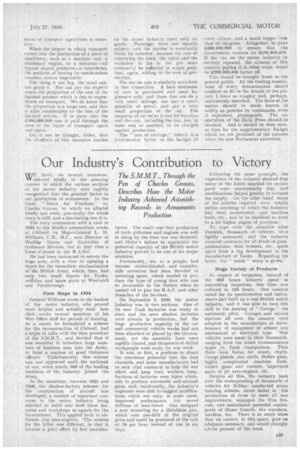Our Industry's Contribution to Victory
Page 25

If you've noticed an error in this article please click here to report it so we can fix it.
The S.M.M.T„ Through the Pen of Charles Graves, Describes How the Motor Industry Achieved Astonishing Records in Armaments Production
ME have, on several occasions,' VV referred briefly to the • amazing manner in which the various sections of the motor industry were rapidly reorganized into the greatest factor in ourproduction of armaments. In the book, " Drive for Freedom," by Charles Graves, to which we alluded briefly dust week, practically the whole story is told, and a fascinating one it is.
The story commences with a visit in 1934 to the derelict ammunition works at Chilwell by Major-General L. H. Williams, C.B., M.C., now Director of Warlike Stores and Controller of Ordnance Services, but at that time a Lieut.-Colonel in the R.A„O.C.
He had been instructed to survey the huge area, with a view to -opening a depot for the immediate mechanization of the British Army, which, then, had Only two small depots for Tanks, vehicles, and Spare parts at Woolwich and Farnborough.
First Steps in 1934 •
General Williams wrote to the leaders of the motor industry, who proved most helpful. and actually took into their _works several members of , his War Office staff for periods of training. As a result, he formulated a scheme for the reconstruction of Chilwell, had a series of talks with the then president of the S.M.M.T., and decided that it was essential to introduce large nuni • hors of business men into the Army, to form a nucleus. of good Ordnance officers. Unfortunately, this scheme was not approved until the outbreak of war, when nearly 500 of the leading menibers of the industry joined the -Army. In the meantime, between 19.35 and 1936, the -shadow-factory scheme for the construction of aircraft was developed, is number of important concerns in the motor industry beiiig selected to build and staff these factories and workshaps as agents for the Government. This applied both to airframes and aero-engines. The selierne _ for the latter was different, in that it became a joint effort by five manufac
turers. The result was that production of both airframes and engines was well in being by the time war was declared, and Hitler's failure to appreciaTte the potential capacity of the British motor industry proved to be one of his major mistakes.
Fortunately, we, as a people, had become motor-Minded, and consider able attention had been devoted to motoring sport, which tended to produce the type of young man who was so invaluable to the Nation when he rushed off to join the R.A.F. and other branches of the Services.
On 'September 3, 1939, the motor industry was in two sections. One of its newTank factories was ready to
start and the aero shadow -factories were already in production, but the
huge productive capacity in the car and commercial vehicle works had not been absorbed or placed by the Govern ment, yet the assembly lines were rapidly cleared, and thousands of Skilled workpeople were ready for war work.
ft was, at first, a problem to direct the enormous potential into the best channels, and sonic manufacturers had to seek vital contracts to help the war effort and keep their workers busy, -Sections of factories were taken wholesale to 'produce autothatie anti-aircraft guns, and, incidentally, the industry's engineers were able to suggest modifications which not only, in some cases, improved performance, hut saved millions of man-hours. One designed a new mounting for a Hotchkiss gun,. which cost one-fifth of the original price and could be produced at the rate of 10 per hour instead of one in six days. Following the same piinciple, the experience of the industry showed that many Of. the limits imposed on certain parts were unnecessarily fine, and modifications helped greatly to increase the supply. Oil the other hand, many of the articles required were totally , unlike anything to which the industry had been accustomed, and machine. tools, etc., had to be modified to work to a far higher degree of precision:
, To cope with the situation -after Dunkirk, thousands Of vehicles we.e lightly armoured, and the industry received contracts for all kinds of guns, ammunition, steel helmets, etc., -quite apart from a big development in the manufacture of Tanks. Regarding the latter, the " inside " story is given.
Huge Variety of Products
In respect of torpedoes, instead of the SOO hours hitherto spent in assembling torpedoes, this time was reduced to 130 hours. • One concern noted for its speedometers and instruments lad built up a real-British watch. industry, and it was able to turn this skill to the making of " George," the automatic pilot. Garages and service stations all over the country were adaptedto the manufacture or maintenance of equipment of almost any mechanical or electrical type. War vehicles were made iii their thousands, ranging frorn the latest reconnaissance types to. Tank transporters. Then there Were horns for mines, depthcharge pistols, star shells, Bofors guns, highly complicated machine . tools, rocket guns and rockets, important parts. of jet aero-engines, etc.
Despite all this, the industry tookover the waterproofing of thousands of vehicles for D-Day, conducted many training 'schools, never failed in the production of tyres to meet all war requirements, equipped the -Fire Service, and-maintained powerful contingents of Home Guards, .fire watchers, wardens, etc. . There is so much more that ive cannot, in this space, give-an adequate summary, and would strongly advise perusal of the book,




















































